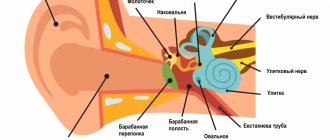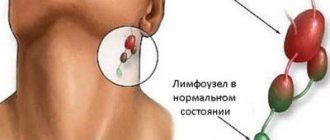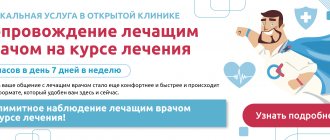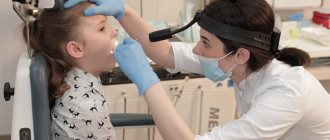Every third appeal to an oncologist on social networks or on remote consultation portals is formulated something like this: “save, help, I have enlarged lymph nodes.”
As a rule, young people write, usually from 18 to 25 years old, and I don’t remember a case when it eventually turned out that the situation required treatment from an oncologist. Most often, enlarged lymph nodes were caused by a sore tooth, sore throat, conjunctivitis, and so on.
It is clear that fear and fears for one’s health in such cases force one to immediately run to an oncologist.
However, is everything so simple, and is it worth rolling your eyes about any treatment with an enlarged lymph node?
My personal statistics show: if a person comes for a face-to-face consultation, he is already one of those few whose situation was not limited to the banal “it got sick and went away.”
Let's take a closer look at how the lymphatic system works and understand the nature of enlarged lymph nodes.
General information
The organs of the lymphatic system play a protective role in the human body. They serve as a barrier to viruses, bacteria, and also filter out harmful substances. In total, there are more than 450 lymph nodes in the adult body, and their maximum number is formed by the age of 10.
Lymph nodes are connected by lymphatic vessels - lymph (a fluid with a high content of lymphocytes, or “white blood cells”) circulates through them. Produced in the bone marrow, lymphocytes circulate throughout the body, first passing through the spleen and then the lymph nodes. Thanks to this, they gain the ability to produce antibodies to destroy microbes. Source: A.G. Rumyantsev, professor, V.M. Chernov, professor, V.M. Delyagin, professor Enlarged lymph node syndrome as a pediatric problem Practical Medicine, 2007, No. 5 (24), pp. 12-15
When an infection enters , a kind of “attack” is carried out on it, as a result of which the lymph nodes can enlarge (during this period they more actively produce antibodies). After recovery, the nodes return to normal size. If their diameter and density do not return to their original state, the child must be shown to a doctor.
What after?
The patient receives doctor's recommendations regarding the recovery period. Usually this period proceeds quickly and easily and does not require serious restrictions.
The results of the study are ready a week to ten days after the procedure. This is quite long because the process of preparing sections is labor-intensive. In addition, sometimes there is a need to clarify the diagnosis using immunohistochemistry.
Having received the conclusion from the laboratory, the doctor makes a final diagnosis and prescribes the necessary treatment.
Indicators of normal lymph nodes:
- diameter up to approximately 5 mm;
- soft consistency;
- single location, that is, lack of connection with each other or with the skin;
- absence of pain upon palpation (palpation);
- mobility.
Reasons for enlargement and main groups of lymph nodes
| Group of lymph nodes | Typical reasons for the increase |
| Parotid | Pyoderma (inflammation of the scalp accompanied by pus), inflammation of the outer or middle ear, the presence of lice, atopic dermatitis, eczema. |
| Occipital | Various inflammations in the scalp, fungal diseases, rubella, etc. |
| Submental | Abscess of the jaw, inflammation of the lower lip, damage to the front teeth, stomatitis. |
| Submandibular | Gingivitis, stomatitis, dental damage. |
| Cervical (in the direction of the muscles at the back of the neck) | Sore throat, chronic tonsillitis, tuberculosis of the tonsils, adenoids, infectious form of mononucleosis. |
| Cervical (middle) | Scarlet fever, tonsillitis, “cat scratch disease”, Hodgkin or non-Hodgkin lymphoma ( important - these are malignant oncological processes!), toxoplasmosis. |
| Cervical (lateral) | Tumors, lymph node tuberculosis, nasopharyngeal infections. |
| Elbow | Infections of the forearm or hand. |
| Axillary | Shoulder or arm infections, vaccine reactions, cat scratch disease. |
| Inguinal | Infections of the skin, bones and muscles of the lower extremities, inflammation of the joints, dermatitis, inflammatory processes in the genitals, reaction to a vaccine introduced into the femoral area. |
Indications for lymph node dissection
The need for lymph node dissection depends on the aggressiveness of the specific disease and the extent of the tumor, that is, the stage of the cancer.
Some tumors hardly metastasize, so lymph node dissection is not used in their treatment. This is, for example, basal cell carcinoma. For the same reason, lymph node dissection is usually not necessary in the early stages of cancer.
However, for rapidly metastasizing cancers, lymph node dissection is a mandatory component of radical treatment. If it is impossible to carry out this procedure, the tumor is considered inoperable. This applies, for example, to gastric cancer, pancreatic carcinoma, and non-small cell lung carcinoma.
In the case of a number of diseases - for example, breast cancer, melanoma, squamous cell carcinoma of the skin - before performing lymph node dissection, a biopsy of the sentinel lymph node is done to determine the presence of metastases in it.
The sentinel node is the lymph node closest to the path of tumor spread. To detect it, mapping is carried out, isolating the affected tissues using labeled isotopes or a dye. After detection, the sentinel node is removed and submitted for morphological examination. If no traces of damage are detected in this node, then lymph node dissection is not prescribed, since the likelihood of metastases is minimal. If tumor cells are found in the sentinel node, then without lymph node dissection, the prognosis worsens.
9500 patients annually
- We accept patients 24/7
- Stabilization, resuscitation, medical care
Call me back!
Oncological alertness
Lymph nodes are often enlarged due to lymphogranulomatosis (Hodgkin's lymphoma) or lymphosarcoma (non-Hodgkin's lymphoma). These are malignant processes that are manifested by increased density, painlessness and large diameter of the lymph nodes in the absence of other reasons for their deformation. Lymph nodes enlarge in groups, asymmetrically (for example, on one side of the neck). At the initial stage of the process, their mobility and separate arrangement are maintained. If the oncological process continues without treatment, the lymph nodes may become fused, and moderate pain rarely occurs. Source: N.V. Nagornaya, E.V. Vilchevskaya, A.P. Luachak, E.N. Marchenko, E.V. Bordyugova, A.P. Koval Hodgkin's disease (lymphogranulomatosis) in children // Child's Health, 2013, No. 1 (44), pp. 13-15
Symptoms that require consultation with a doctor are enlarged lymph nodes:
- more than 7 days;
- more than 1 group;
- accompanied by elevated body temperature;
- in a child under one year old;
- progressive over time;
- with changes in local skin.
How is lymph node dissection performed?
Removal of lymph nodes is carried out with mandatory adherence to certain principles developed in oncology and designed to minimize the risk of new metastases.
Firstly, it is not a separate lesion that is removed, but the tumor along with the surrounding tissue and lymph nodes as a single block, during one operation (monoblock principle).
Secondly, lymph node dissection is performed according to the zonal principle, taking into account anatomical boundaries. This means that it is impossible to remove only individual nodules with metastases from different zones (zoning principle).
Thirdly, metastases must be removed taking into account their relationship with neighboring structures (the principle of casing).
Lymph node dissection can be performed openly or endoscopically under general anesthesia.
If lymph node dissection is performed in the thoracic, abdominal or pelvic cavity, the organ affected by the tumor is first removed, then the lymph nodes and internal tissue. During lymph node dissection, the fatty tissue along with the lymph nodes is separated from the muscles and removed.
After removal of the lymph nodes, ligation and intersection of the vessels are performed, then the surgical wound is sutured.
Often, lymph node dissection takes longer than removal of the primary tumor focus.
After the operation, the obtained material is submitted for morphological examination.
9500 patients annually
- We accept patients 24/7
- Stabilization, resuscitation, medical care
Call me back!
Diagnostic methods
After examination and collection of complaints and medical history, the specialist sends the child for a general examination . It includes x-rays, blood and urine tests . Additionally, the following studies may be needed:
- blood serology;
- diagnosis of tuberculosis;
- lymph node biopsy followed by cytological examination in the laboratory;
- Ultrasound.
Sometimes children are prescribed antibacterial drugs as part of the diagnosis. Based on their effectiveness, they confirm or refute the bacterial nature of the disease.
Treatment methods
Enlarged lymph nodes are not an independent disease, but a symptom of some other disease. Therefore, therapy in this case comes down to eliminating the root cause of this reaction. The rate at which nodes return to normal size varies, depending on the severity and type of underlying disease.
If a child gets sick very often, then immunomodulators are recommended to strengthen the body's defenses. The choice of drug should be made only by a doctor.
Important! Enlarged lymph nodes should not be heated - this can lead to the development of suppuration and blood poisoning! Any self-medication is prohibited - the reason and type of therapy is determined by a specialist.
Why do lymph nodes enlarge with cancer?
As a cancerous tumor grows, its cells begin to wash out into the lymph, entering the lymphatic capillaries and then into the lymph nodes closest to the lesion. Doctors call them watchdogs. Lymphocytes try to destroy malignant cells, but, as a rule, to no avail. As a result, a tumor focus (metastasis) begins to grow in the lymph node.
Having broken through the first level of defense in the form of sentinel lymph nodes, cancer cells spread further to distant parts of the lymphatic system, and then to organs and tissues. As a result, tumors begin to grow far from the primary focus - in the liver, lungs, and brain. In cancer patients, ultrasound reveals enlarged lymph nodes in various parts of the body.
The larger the tumor, the higher the likelihood of lymph node involvement. Sometimes lymphadenitis occurs before the detection of a tumor focus and is the main symptom with which patients consult a doctor.
Advantages of contacting SM-Clinic
“SM-Clinic” is a team of some of the best specialists in St. Petersburg, advanced diagnostic equipment and comfortable conditions. We have no queues, all examinations are carried out quickly, appointments are conducted by highly qualified doctors.
If your child has enlarged lymph nodes in the neck or in any other area, you should urgently contact a specialist for diagnosis and treatment. Delay in some cases is very dangerous!
To make an appointment with a pediatrician, immunologist or other pediatric specialist, call us.
Sources:
- A.G. Rumyantsev, professor, V.M. Chernov, professor, V.M. Delyagin, professor. Syndrome of enlarged lymph nodes as a pediatric problem // Practical Medicine, 2007, No. 5 (24), pp. 12-15.
- N.V. Nagornaya, E.V. Vilchevskaya, A.P. Luachak, E.N. Marchenko, E.V. Bordyugova, A.P. Koval. Hodgkin's disease (lymphogranulomatosis) in children // Child's Health, 2013, No. 1 (44), pp. 13-15.
Grek Elena Anatolyevna Clinic
Author of the article
Grek Elena Anatolyevna
Doctor of the highest qualification category
Specialty: immunologist
Experience: 24 years
The information in this article is provided for reference purposes and does not replace advice from a qualified professional. Don't self-medicate! At the first signs of illness, you should consult a doctor.
What to do if the lymph nodes in the neck are inflamed: causes and treatment
Lymphadenitis is an inflammation of the lymph nodes in the neck; we will talk about the symptoms, treatment and causes of the disease in the article.
The job of the lymph nodes is to filter lymph along the bloodstream so that pathogens do not reach vital organs. It is thanks to them that a large number of lymphocytes, that is, cells of the immune system, appear in the blood. When a patient falls ill, their number increases significantly, and along with them, the spherical nodules that are located in the groin, in the elbow and knee bends, in the sternum and abdominal cavity become larger in size. But the most important lymph nodes are located in the neck. They protect the main veins and arteries so that the infection does not penetrate the brain.
Types of lymphadenitis
The disease can be called an auxiliary condition and even a symptom of something more dangerous, because it does not occur on its own, but only in combination with another inflammatory diagnosis.
When the immune system in the human body fails and a focus of disease forms, pathogens travel through the bloodstream to one of the lymph nodes. In this territory, with the help of leukocytes and lymphocytes, the sick person wins. But if the cause is strong enough and foreign pathogenic agents appear in large quantities, then the first signs of inflammation of the lymph nodes in the neck appear, namely, their increase in size. This occurs due to the active production of immune cells.
But depending on the location, severity and method of infection, there are several classifications.
By method of infection:
- hematogenous, that is, through the blood, when a lesion appears in one part of the body, and the pathogen reaches the lymph node through the veins or arteries;
- contact, occurs in cases where nearby organs, for example, the nasopharynx, are infected;
- mechanical - due to damage to tissues and skin near the lymph node with subsequent penetration of the pathogen.
According to the source of infection, lymphadenitis occurs:
- Specific. The most classic clinical picture is when the patient has swollen cervical lymph drainages due to infection with candida or bacteria. Usually these are staphylococci or streptococci, that is, the most common pathogens of sore throat, tonsillitis and other colds.
- Non-specific. Pathology develops as an exacerbation of diseases that lead to a sharp decrease in the immune system. This often happens with HIV or tuberculosis. In this case, in addition to treating the underlying disease, a significant dose of immunostimulants is prescribed.
According to the severity of the flow:
- Spicy. It is characterized by the rapid onset of swelling, pain and severe inflammation of the cervical lymph nodes. Symptoms intensify rapidly and may affect nearby nodes. If treatment is incorrect or untimely, serious complications can occur.
- Chronic. This is a long-term course of the disease with increasing symptoms and risks of progressive morbidity. Typically, this stage begins in cases where proper treatment was not carried out at the initial stage of the inflammatory process.
- Reactive, that is, very fast. The process lives up to its name because, apart from swelling and pain in the ear or jaw area, there are no other signs of the disease.
According to the clinical picture:
- Purulent - the bacterial focus is located next to the immune defense organs, so if pus occurs, it can also affect them. The active reproduction of pathogens also continues in the lymph nodes. Without urgent antibiotic therapy or, in some cases, without surgical intervention, there is a high risk of abscess rupture. As a result, the pathogenic mass can reach vital organs, including the brain.
- Catarrhal. Occurs with significant redness of soft tissues. This happens due to the fact that blood capillaries burst, releasing blood.
- Granulomatous. Granulomas are clots of blood and lymphatic cells that are mixed into a single mass. They often appear on the skin in the form of plaques, reddish spots, and rashes.
- Serous. A cloudy sediment is released in the tissues. The exudate partly consists of lymphocytes. This leads to a general deterioration in health, as the immune system actually stops working. Also, in this condition, inflammation of the lymph nodes on the right and left neck occurs very rapidly, they can reach significant sizes.
- Hyperplastic. This is such an advanced stage of the disease, when the volume of the node grows from the classic 2-3 millimeters to several centimeters.
- Necrotic. The most dangerous type because it causes cells to die.
By the number of affected lymphatic drainages:
- single - only one area is affected;
- regional, also known as multiple – damage to an entire region;
- total – all or most of the groups of lymph nodes throughout the body.
Another classification divides ailments by location. But we will focus only on the cervical-collar area.
Symptoms of increased lymphoid tissue
With lymphadenitis, it is considered normal if the inflammatory process occurs symmetrically. If, on the contrary, the lesion is only in one direction, then there is a risk that the pathology is of an oncological nature. But before contacting an oncologist, you should pay attention to the symptoms. Classic manifestations:
- Temperature increase. As with any other inflammation, leukocytes begin to be actively produced to fight infection. Their concentration in the body, together with toxic waste products of bacteria, leads to symptoms of intoxication. That is, to weakness, drowsiness, low fever, and an apathetic state. All this goes along with a fever, which usually does not reach more than 38.5 degrees. If the thermometer reads over 39, you should immediately consult a doctor. In some cases, this may be caused by a concomitant disease, such as tonsillitis. But if the throat does not hurt, then such a high temperature may indicate a purulent or serous nature of the disease, which is dangerous.
- Upon palpation, pronounced bumps can be detected. They can be small and increase over time.
- All soft tissues of the neck swell slightly. The swelling puts pressure on the larynx, making it difficult for the patient to speak and swallow.
- When turning or tilting the head, the pain intensifies.
All these symptoms are characteristic of a condition such as lymphadenopathy. This diagnosis should not be confused with lymphoma, that is, with cancer. But you should be examined for possible cancer.
Side symptoms may include:
- enlargement of the tonsils and their pain when swallowing;
- swelling of the salivary and lacrimal glands;
- swelling of the thyroid gland.
If you see such manifestations in yourself, your loved ones or your child, you should immediately visit a doctor. We strongly do not recommend using methods that increase body temperature as self-medication. Also, you should not carry out procedures that involve heating the lymph nodes. That is, you cannot make compresses, lotions or steam baths for your feet. This can only make the situation worse.
Before being examined by a specialist, you can start taking the immunomodulator Cytovir-3. This is a domestically produced drug that has virtually no contraindications or possible negative consequences. It should be taken for 4 days to increase endogenous interferon levels. Active substances (bendazole, thymogen and ascorbic acid) stimulate the natural production of protective proteins. This will ease the course of the disease and help in recovery.
What to do and who to go to if you have inflammation of the lymph nodes in the neck
If the symptoms are closely related to catarrhal or purulent tonsillitis, tonsillitis, pharyngitis, sinusitis or classic sinusitis, then we can talk about the probable connection of these diseases with lymphadenitis. Most likely, after a full course of treatment for colds of the upper respiratory tract of a bacterial nature, the inflammatory process will also pass. Therefore, you should contact a therapist or ENT specialist.
The following can also work in tandem with them:
- immunologist - we have already noted that lymphoid tissues are closely related to immunity;
- infectious disease specialist - to determine the type of infection;
- oncologist - referred to him in rare cases of reactive lymphadenopathy or other signs of possible lymphoma.
Diagnostics
The specialist will ask you to name the symptoms, ask when the first signs appeared, and also with what intensity they are now bothering you. He then palpates the affected area to determine the diameter of the lymph nodes. If a non-infectious cause is suspected, an ultrasound may be ordered. You will also need to donate blood and urine to check for an increased number of white blood cells and the presence of toxic substances.
The immunologist will also do an immunogram. This test will help give an objective picture of the state of your immune system. In case of poor or insufficiently satisfactory results, immunomodulators may be prescribed.
Causes of inflammation of the lymph nodes in the neck in an adult woman or man
In diseases of the upper respiratory tract, an inflammatory process occurs, which leads to the spread of infection through the bloodstream. And since the cervical lymph drainage is closest to the site of infection, the inflammatory process occurs there first. Therefore, the first and main reason is the accompaniment of such diagnoses as tonsillitis or tonsillitis. And the stronger the disease, the larger the tumor becomes, the pain intensifies, and upon palpation you can feel dense lymphoid tissue the size of a walnut or even a chicken egg.
But not only bacteria can become the causative agent of lymphadenitis. This can lead to:
- HIV;
- cancer metastases;
- Sharp's syndrome or other connective tissue pathologies;
- frequent consumption of alcoholic beverages;
- chronic immune problems and frequent illnesses;
- disorders of the thyroid gland;
- otitis media;
- caries or other dental infections;
- STD.
Mechanical damage to the skin, for example, a scratch from a rodent or pet, can also lead to such a reaction in the body. Let's take a closer look at the possible reasons depending on the location.
On right
- infectious diseases of the throat;
- failure of one side of the thyroid gland;
- inflammation of the right tonsil;
- caries.
Left
In addition to the above-mentioned factors, which can occur on both halves, left-sided swelling may indicate disturbances in the gastrointestinal tract and abdominal cavity. Can be diagnosed:
- cytomegalovirus;
- toxoplasmosis.
Behind
If the pain radiates to the occipital region, then there is a high probability that the patient has infectious mononucleosis, which develops under the influence of the Epstein-Barr virus.
This is a very dangerous diagnosis, which may cause photophobia, facial swelling, cough, chills, fever, red throat and cough. Due to the enlargement of the spleen, the stomach begins to ache.
Behind the ear
The reasons may be:
- otitis;
- mumps;
- rubella;
- boil or other purulent formations on the ear canal.
Under the jaw
The submandibular nodes become inflamed, as a rule, with serious disorders of the immune system or with frequent or chronic diseases. This can be caused by:
- arthritis;
- Wagner's syndrome;
- lupus erythematosus;
- serum sickness.
Treatment of inflammation of the lymph nodes in the neck in an adult
If you have an elevated temperature, you should take antipyretics. At the same time, therapists do not recommend taking medications up to 38.5 degrees, since such a mark indicates an active independent fight of the body against pathogens. In case of extreme heat, you can take antipyretics: Paracetamol, Voltaren, Ibuklin.
If the cause is otitis media, caries, boils or other concomitant diseases, then you need to cure them first, then the swelling will subside over time on its own.
In case of chronic lymphadenitis, an immunogram should be done, since the main reason is reduced immunity. You should start taking immunomodulators. The drug “Tsitovir-3” has a good effect from this category of drugs. It quickly and efficiently increases the level of interferon in the blood, which facilitates the work of the lymph nodes.
In case of purulent course of the disease, you should strictly follow the specialist’s recommendations. He can assign:
- Antibiotics intravenously or orally. It is imperative to finish the prescribed amount of medication, otherwise there is a risk of relapse.
- Bed rest. For children, as well as for patients with an advanced stage of the disease or complications, hospitalization will be required.
- Surgery - in rare cases, when there is a risk of abscess rupture.
- Physiotherapeutic procedures using stimulation of lymphoid tissue with current or laser.
If the inflammation is caused by a virus, then antiviral drugs may be prescribed.
In rare cases, Prednisolone is prescribed. It helps replenish the secretion that is secreted by the adrenal glands and regulates the level of leukocytes and lymphocytes.
Among the external methods of therapy, the following ointments can be distinguished:
- "Heparin".
- "Vishnevsky".
- "Diclofenac".
They relieve inflammation and relieve pain. It should be noted that they should be used only in combination with tablets.
Complications
Since lymphatic drainage clears the bloodstream of infection, if the functioning of the lymph nodes is disrupted, there is a high probability that pathogens will spread throughout the body and affect vital organs. If they reach the brain, meningitis may begin.
The second danger is sepsis, that is, blood poisoning. Such a consequence may occur after the purulent course of the disease.
When entering the chronic stage, relapses may occur frequently, and the immune system will be greatly weakened.
Prevention
As a preventive measure, you should strengthen your immune system and try to avoid upper respiratory tract diseases. Need to:
- Eat properly. Your diet should include fresh vegetables and fruits every day. Eliminate fast food and soda.
- Maintain hygiene. Wash your hands after every visit to public places with large crowds of people.
- Gradually harden.
- Strengthen your body through exercise and sports.
- Walk outdoors more often.
- Take a course of Cytovir-3 2-3 times a year.
In the article, we explained what types of lymphadenitis there are, what causes it, and how to treat inflammation of the lymph nodes in the neck. Be attentive to your health and consult a doctor at the first signs.
Prices
| Name of service (price list incomplete) | Price |
| Appointment (examination, consultation) with an allergist-immunologist, primary, therapeutic and diagnostic, outpatient | 1750 rub. |
| Consultation (interpretation) with analyzes from third parties | 2250 rub. |
| Prescription of treatment regimen (for up to 1 month) | 1800 rub. |
| Prescription of treatment regimen (for a period of 1 month) | 2700 rub. |
| Consultation with a candidate of medical sciences | 2500 rub. |
| Allergen-specific immunotherapy (ASIT) - maintenance course (excluding the cost of the drug) | 8100 rub. |











